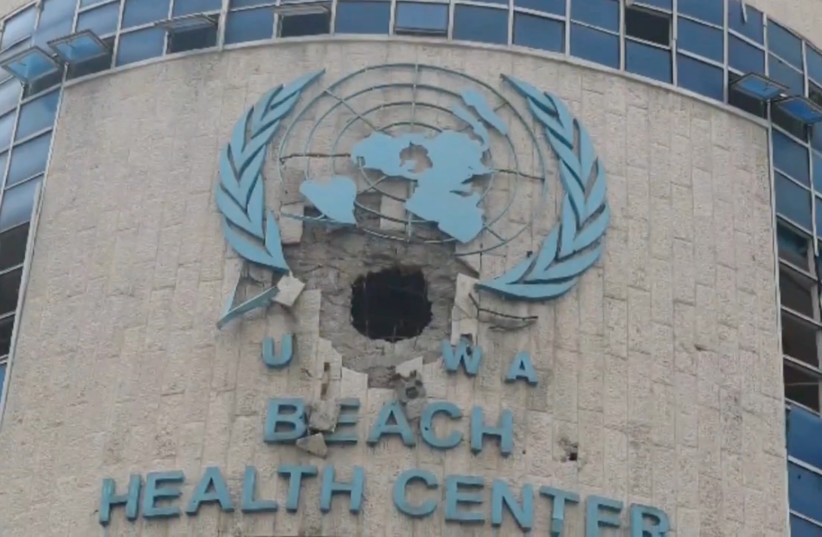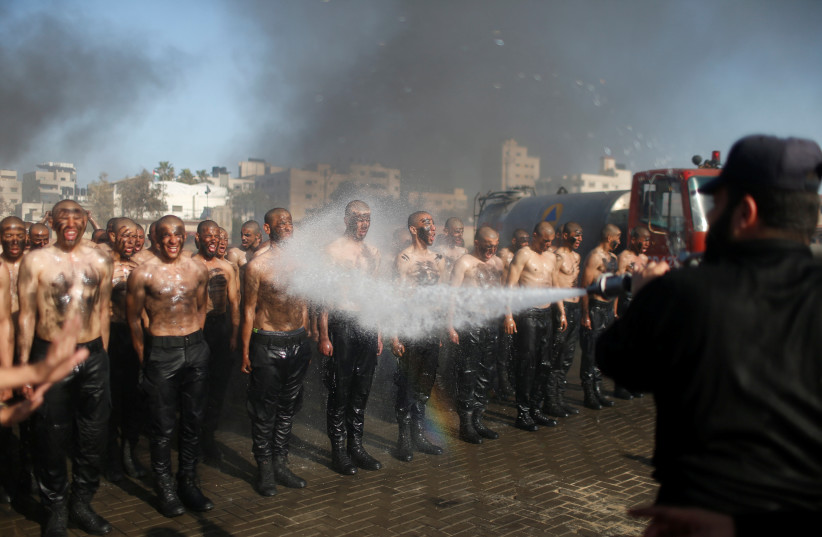On Friday, Defense Minister Yoav Gallant shared further details about the 12 UNRWA employees accused of participating in the October 7 attack on Israel. The details are important because they shed light on the background of the men and key aspects of how they were connected to the attack. This possibly provides a window into a larger story about those participating in the massacre of October 7.
First of all, here are a few details that Gallant shared on Friday. “In addition to these 12 workers, we have significant indications, based on intelligence, that over 30 UNRWA workers participated in the massacre, facilitated the taking of hostages, looted and stole from Israeli communities, and more,” he said. This means UNRWA has lost its legitimacy and Gallant has “instructed the defense establishment to begin transferring responsibilities related to the delivery of aid, to additional organizations.”
Israel believes that out of 13,000 UNRWA employees, 12% percent are affiliated with Hamas or Palestinian Islamic Jihad. “185 UNRWA workers are active in the military branches of Hamas and 51 are active in the PIJ military branch,” Gallant said. Hamas has exploited this to use UNRWA institutions to store weapons and also build tunnels under them.
What might these details reveal about the larger picture of October 7? If we assume that UNRWA’s employees are representative, to some extent, of the wider society in Gaza, then is it possible to conclude that Hamas has successfully infiltrated around ten percent of Gaza? Certainly, Hamas, when there were Palestinian elections, polled larger than ten percent. But it didn’t always poll so high. There was a time when the extremist group had only a small number of hard-core murderous supporters. Therefore, it may be reasonable to conclude that removing Hamas from Gaza or at least removing it from being embedded into the civilian society, is possible. This is because disentangling it from the 90 percent who are not connected to it is likely possible.
The number of members compared to the number who are actively involved in fighting is also interesting. Gallant said that Israel believes that there are 1,468 members of UNRWA who are active in Hamas or PIJ. However, of those, a total of 185 are involved in the “military branch,” and 51 are part of PIJ. This could illustrate that even among those who are members of Hamas in Gaza, around ten percent of them are actually fighters. Let’s do a little math here now. There are around two million people in Gaza. Half of them are men. While women are active in Hamas, men make up the terrorists in the Hamas battalions in Gaza. Therefore, let’s say there are a million males in Gaza, but half of them are under the age of 18, according to most reports on the demographics of Gaza. Therefore, there are around 500,000 potential adult male recruits for Hamas. Some of these men are too old, and the UNRWA list of 12 men shows that many were born in the 1970s and 1980s. Therefore, the actual demographic of recruits might be around 300,000. Hamas recruits teenagers and children through summer camps, but it’s hard to know how many teens might be members of their fighting group.
If we take 300,000 potential recruits and take ten percent of that, we get 30,000, which is the actual estimate used for the size of Hamas battalions. Has Hamas successfully recruited ten percent of the military-age men in Gaza? Maybe it has. But the UNRWA numbers tell us that in places where civilians do support Hamas or are active with the group, maybe ten to twenty percent will be part of its terrorist squads.

What this may reveal is that Hamas doesn’t have a huge pool of recruits to bring in new men to its battalions. The IDF estimates that it has eliminated around 10,000 Hamas fighters and wounded another 10,000. That represents around 18 of the 24 Hamas battalions in Gaza. Many of those battalions began the war with around 1,000 men and have lost several hundred men in battle and seen another few hundred wounded. That means they are down to just a third of their original strength.
How would Hamas fill these ranks again? Clearly, it would have to resort to pressing teenagers into its ranks or going deep into the battling order by recruiting older civilians who support Hamas but had chosen not to be fighters. That means recruiting people who already chose not to be active fighters.
Biographies of UNRWA Hamas members reveal details of October 7
The men who have been identified by Israel as being UNRWA employees and also participating in the October 7 attack were mostly in their forties, born between 1974 and 1983. Only a few were younger. Many of them are accused of being active in various Hamas units, and they played key roles, such as platoon and company commanders. On October 7, one of them received hostages, one was involved in a kidnapping, and one assisted his son in a kidnapping. Three of them received an SMS on the morning of October 7 calling them to a muster station where Hamas was bringing men to carry out the attack. The way Hamas activated these cells is interesting. These men may have trained for October 7 for years; they didn’t know the details of the date, but they were told to be ready.
Many of the men were educators, often teachers. This would appear to illustrate that they were not merely working for UNRWA as a way to have a fake day job while actually working for Hamas full-time. Basically, what this means is these men were not involved in what is called “disguised unemployment,” where large organizations are encouraged to employ large numbers of people who don’t actually do anything at work. A math teacher, for instance, would likely be missed at school if he didn’t teach math. Of course, it’s possible that he was simply paid as a “teacher” and never showed up. One of the men was a deputy school principal, which would likely require him to be at work. Other men were school “counselors,” which might be a job they never had to actually turn up to.
However, the large number of men who were educators and also active in Hamas and apparently active in the fighting squads of Hamas, or at least key parts of the organization’s military structure, would point to a larger problem in Gaza of education being infiltrated by Hamas. Hamas clearly wants to infiltrate schools so it can conquer the next generation. That way, even if it loses the war, the young people who were influenced by these teachers will come of age and back Hamas. Since many of these men were in their forties, it stands to reason that they joined Hamas around the time that Hamas took power in Gaza. They might have joined in their teen years, but it seems more reasonable that they saw a career opportunity after 2007 to join Hamas and also be employed at UNRWA, the best of both worlds in their view. These men also survived previous wars such as 2009, 2012, and others, meaning their “military” role in Hamas didn’t expose them to actual combat in 2014 or other conflicts.
Demographics playing a key role

Another aspect of the list of twelve men is that most are from Nuseirat, which is one of the central camps in Gaza. This lopsided regional aspect for the men could mean that a lot of Hamas members come from Nuseirat. Hamas has always performed well in some of the refugee camps in Gaza, which are its roots and make up its shock troops. On the other hand, it could point to some other type of bias in the information being released. Were men from Nuseirat simply more likely to be caught on October 7 and they left their phones on during the attack, a failure of operational security from Hamas’ perspective. Or is Nuseirat simply overrepresented because UNRWA in Nuseirat has been deeply infiltrated by Hamas?
There is a lot we don’t know. As the late Donald Rumsfeld was fond of saying, there are known unknowns and unknown knowns. The demographics of the Hamas members of UNRWA likely reveals a lot about Hamas in Gaza, but it leaves us with a lot of known unknowns. Defeating Hamas will mean getting to those unknowns.
